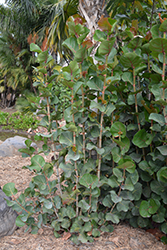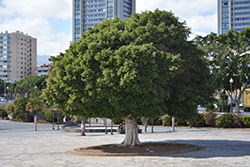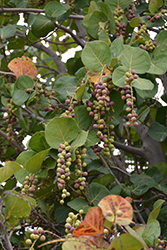Fri & Sat 8am - 8pm
Sun 8am - 7pm
Anytown, USA 12345
fax: 261.787.0463
e-mail: info@successgc.com


Plant Finder

Height: 40 feet
Spread: 50 feet
Sunlight:
![]()
![]()
Hardiness Zone: 10a
Other Names: Baygrape
Description:
A coastal evergreen tree native to tropical America and the Caribbean; large round, leathery green leaves turn bright red before they are replaced by bronze new foliage in winter; edible grapes on female trees only, ripen in late summer
Edible Qualities
Seagrape is a large tree that is commonly grown for its edible qualities, although it does have ornamental merits as well. It produces small clusters of red round fruit with a purple blush which are typically harvested when mature. The fruit will often fade to deep purple over time. The fruits have a tart taste and a fleshy texture.
The fruit are most often used in the following ways:
- Preserves
Features & Attributes
Seagrape has attractive grayish green foliage with red veins which emerges coppery-bronze in spring on a tree with a round habit of growth. The large round leaves are highly ornamental and turn outstanding shades of orange and in the fall, which persists throughout the winter. It features subtle clusters of creamy white flowers at the ends of the branches from late winter to late spring. It produces abundant clusters of red grapes with purple blush from mid summer to early fall, which fade to deep purple over time. The smooth gray bark adds an interesting dimension to the landscape.
This is a dense multi-stemmed evergreen tree with a more or less rounded form. Its strikingly bold and coarse texture can be very effective in a balanced landscape composition. This is a relatively low maintenance plant, and can be pruned at anytime. It is a good choice for attracting birds, butterflies and squirrels to your yard. It has no significant negative characteristics.
Aside from its primary use as an edible, Seagrape is sutiable for the following landscape applications;
- Accent
- Shade
- Mass Planting
- Hedges/Screening
- Windbreaks and Shelterbelts
- Naturalizing And Woodland Gardens
Planting & Growing
Seagrape will grow to be about 40 feet tall at maturity, with a spread of 50 feet. It has a low canopy with a typical clearance of 3 feet from the ground, and should not be planted underneath power lines. It grows at a medium rate, and under ideal conditions can be expected to live for 50 years or more. This is a dioecious species, meaning that individual plants are either male or female. Only the females will produce fruit, and a male variety of the same species is required nearby as a pollinator.
This tree can be integrated into a landscape or flower garden by creative gardeners, but is usually grown in a designated edibles garden. It does best in full sun to partial shade. It is very adaptable to both dry and moist growing conditions, but will not tolerate any standing water. It is considered to be drought-tolerant, and thus makes an ideal choice for xeriscaping or the moisture-conserving landscape. This plant will benefit from an application of bonemeal and/or mycorrhizal fertilizer at the time of planting. It is not particular as to soil type or pH, and is able to handle environmental salt. It is somewhat tolerant of urban pollution. This species is native to parts of North America.


